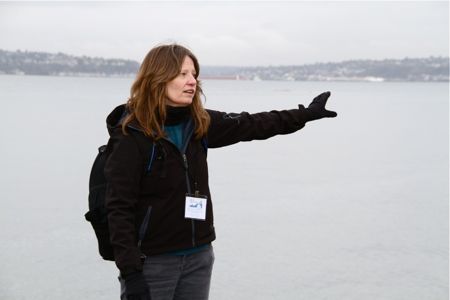
Story and photos by Ellen Cedergreen
Reporting for West Seattle Blog
Long before a Seal Sitters volunteer turns up on the beach, guarding a pup, there’s training involved, and rules to learn.
Saturday at Alki Beach, Seal Sitters’ volunteer coordinators Robin Lindsey (for West Seattle) and Rachel Mayer (for most points north) led a hands-on training session for volunteers. The discussions began at Alki Statue of Liberty Plaza, with the dozen-plus volunteers eventually making way to two other points along the beach.
Volunteers from all over the city attended, since Alki’s unique terrain proved to be perfect for setting up a variety of perimeter demonstrations.

(Seal Sitters’ first responder Robin Lindsey)
The training began with instruction on how to handle a variety of potential situations on site and also included perimeter-establishment demonstrations at two (theoretically typical) potential haul-out sites. Volunteers who have completed the training have access to kits which include: marine mammal tape, stakes, brochures, and “Seal Sitters” business cards. Some kits also include binoculars and other educational materials.
Perimeter tools serve to protect the seal pups, who are very sensitive to noise and peripheral commotion. Many potential scenarios were highlighted, including one of the most common: Dogs. Despite a city ordinance against dogs on Seattle area beaches, it’s still a common occurrence, and many dogs are also off leash. While most people don’t believe their dog would ever harm a seal pup, it can happen, with possibly lethal results. In addition, most people don’t know that seals carry diseases which are communicable to dogs and transferable to humans via a pretty nasty bite; so when people see a seal pup resting on the beach, they may not even consider the potential harm to themselves or their pets.

Seal Sitters volunteers are there first to protect the seals, but they are also there to educate. They aren’t expected to know everything about the marine mammals, nor are they expected to diagnose or treat injured pups; but they are expected to report harassment situations to NOAA, since harbor seals are protected under the Marine Mammal Protection Act. In situations requiring immediate attention, however, volunteers are advised to call 911. But most citizens want to help, and once they know to give the pups some resting space, they will go out of their way to inform others on the beach.
Other ways to help include making any size of tax-deductible donation () , especially now, since it’s been a big year and the group is running low on things like “marine mammal” tape — used to establish a safe perimeter at haul-out sites.
Volunteer coordinator Rachel Mayer told WSB that the group is unsure if there are more pups this year, or if awareness is just at an all-time high. Either way, the pups are getting the necessary protection they need in order to return to the waters when ready, and the public is getting a chance to learn about and enjoy the seals from a safe distance.
Volunteers are always needed at points throughout the city, including West Seattle, and would-be Seal Sitters should contact sealsitters@me.com to learn more about upcoming trainings. And as always: if you spot a seal pup on a public beach, do not approach it. Instead, call the Seal Sitters hotline at: 206-905-SEAL (7325).
You can also keep up with the latest pup sightings, and other “news on the beach,” through the Seal Sitters’ blubberblog.org journal, which also features Robin Lindsey’s video and photos:

(Photo of Queen Latifah is by, and used with permission of, Robin Lindsey)

| 2 COMMENTS